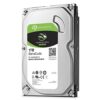Arctic Alumina Premium Ceramic Thermal Compound (14g)
€ 9,40

Arctic Alumina Premium Ceramic Thermal Compound – Thermische pasta – 14 gram
Uitverkocht
Wil je geïnformeerd worden wanneer dit product weer op voorraad is?
Arctic Alumina™
Premium Ceramic Thermal Compound
|
Introducing Arctic Alumina Thermal Compound. The first ceramic-based, polysynthetic thermal compound for use between modern high-power CPUs and high performance heatsinks or water-cooling solutions. |
||||
|
Features: Premium Ceramic Content: |
 |
|||
|
Controlled Triple Phase Viscosity: |
||||
|
NOTE: (This should not be confused with conventional phase change pads that are pre-attached to many heatsinks. Those pads melt each time they get hot then re-solidify when they cool. The viscosity changes that Arctic Alumina goes through are much more subtle and ultimately much more effective.) |
||||
Absolute Stability:
Arctic Alumina will not separate, run, migrate, or bleed.
Electrical Insulator:
Arctic Alumina does not contain any metal or other electrically conductive materials. It is a pure electrical insulator, neither electrically conductive nor capacitive.
Performance:
2 to 10 degrees centigrade lower CPU full load core temperatures than standard thermal compounds or thermal pads when measured with a calibrated thermal diode imbedded in the CPU core.
Easy Clean Up:
Arctic Alumina can easily be cleaned from CPUs and heatsinks with ArctiClean, isopropyl alcohol or any of the cleaners listed in the product instructions.
Compliancy: RoHS Compliant.
Specifications:
Average Particle Size:
<0.39 micron <0.000015 inch (65 particles lined up in a row equal 1/1000th of an inch.
Temperature Limits:
Peak: –40°C to >160°C
Long-Term: –40°C to 125°C
Coverage Area:
1.75-gram syringe. (Approximately 1cc)
At a layer 0.003″ thick, one syringe will cover about 24 square inches.
14-gram syringe. (Approximately 9cc)
At a layer 0.003″ thick, one syringe will cover about 192 square inches.
Important Reminder:
Due to the unique shapes and sizes of the particles in Arctic Alumina, it will take a minimum of 36 hours and several thermal cycles to achieve maximum particle to particle thermal conduction and for the heatsink to CPU interface to reach maximum conductivity. (This period will be longer in a system without a fan on the heatsink.) On systems measuring actual internal core temperatures via the CPU’s internal diode, the measured temperature will often drop slightly over this “break-in” period. This break-in will occur during the normal use of the computer as long as the computer is turned off from time to time and the interface is allowed to cool to room temperature. Once the break-in is complete, the computer can be left on if desired.
Related Information:
Arctic Alumina SDS:
Safety Data Sheet
Instructions:
How to apply thermal compound
| EAN | 0832199002042 |
|---|
Wees de eerste om “Arctic Alumina Premium Ceramic Thermal Compound (14g)” te beoordelen Reactie annuleren
Je moet ingelogd zijn om een beoordeling te plaatsen.




Beoordelingen
Er zijn nog geen beoordelingen.